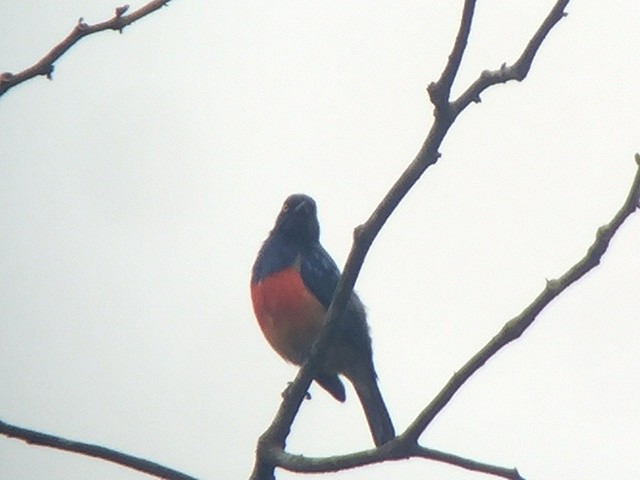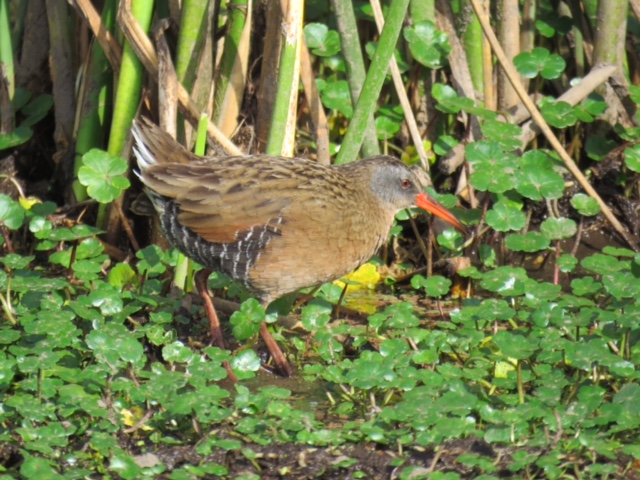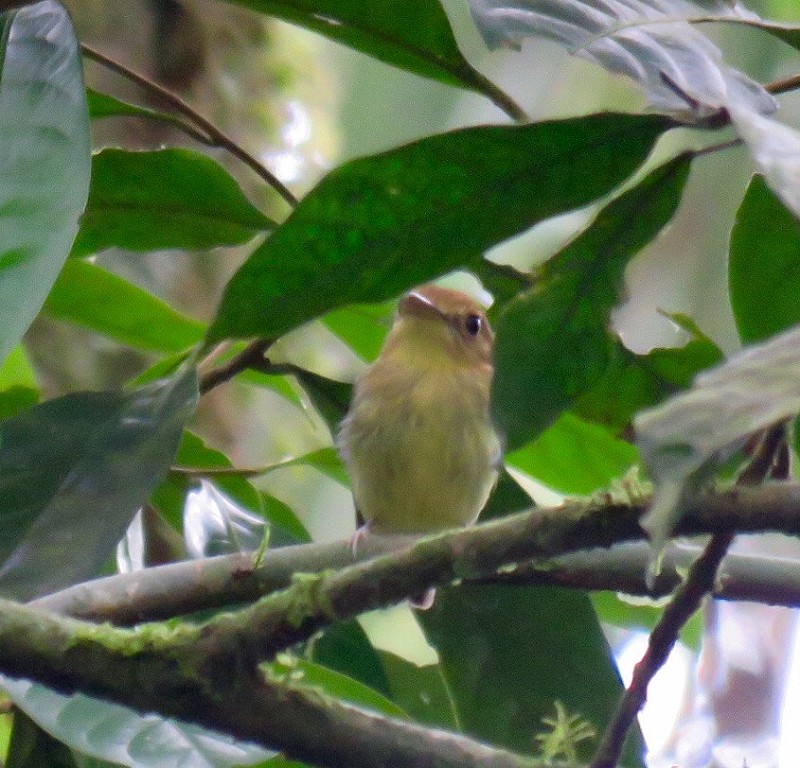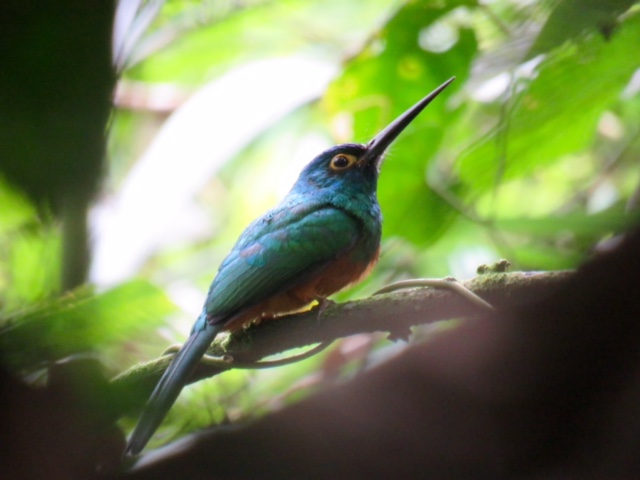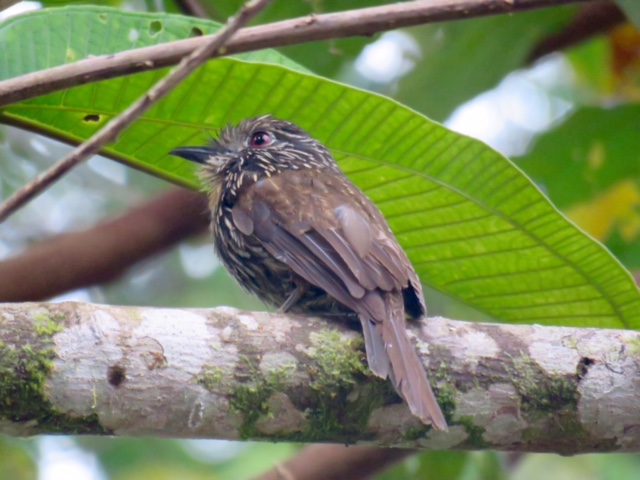October 2 - 9: Ecuador (2)
11 October 2016 · Arjan Dwarshuis · 6927 × bekeken
PLEASE MAKE A DONATION NOW!
world.observation.org/arjan
www.arjandwarshuis.com/#biggestyear
October 1st A DUTCH REUNION IN QUITO
After my fight from Coca to Quito I took a taxi to the house of my friend Dusan Brinkhuizen. Dusan – a fellow Dutchman – lives in Ecuador with his wife for many years now and guides for Rockjumper Tours. Up until two months ago Dusan would have guided me in Ecuador, but then the unthinkable happened; he horrifically broke his leg while playing basketball. Luckily Dusan will recover completely, but it will take another 3 weeks before he can walk without crutches. So for the next 8 days I will be birding on my own in Ecuador with Dusan’s trusty driver Rolando. Dusan will guide me from a distance and I will leave with all his sound recordings and detailed site information. This will be one of the biggest challenges of my Big Year especially since I’ll be covering the Choco Lowlands, one of the tougher regions in the Neotropics…
Dusan and his wife gave me a warm welcome when I arrived at their lovely apartment in suburban Quito and while I enjoyed a lunch I could add - according to Dusan – the only Crimson-backed Woodpecker in Quito to my list. After lunch the 3 of us took a taxi to Dusan’s local patch, the Quito Botanical Gardens. For him this was the first time to go birding in two months, for me it was the first time to be birding with a cripple this year ;-) Handicapped as he might be, Dusan was still sharp as ever and he managed to find me my first Yellow-green Vireo for the year.
That evening we drank beer and planned my loop through northwester Ecuador in detail.
October 2nd MIST MAKES LIFE DIFFICULT
Early morning I was picked up by Dusan’s trusty driver Rolando and together we headed towards Yanacocha Reserve, an hour’s drive from Quito. This reserve is famous for having the critically endangered Black-breasted Puffleg, but this bird has not been seen for a long time. Still there are some other great birds to be found in the elfin forest.
My first target was the beautiful Black-chested Mountain Tanager which I luckily found quickly. The other 3 important once were all hummingbirds which are to be looked for around the feeders at the end of the track. By mimicking the sound of a pygmy owl however I had lured in all three species – Sapphire-vented- and Golden-breasted Puffleg and Buff-winged Starfrontlet – before getting there, so I turned around and we headed for Bellavista Reserve. I had very high expectations of this place since 3 awesome birds are quite regularly found there, namely Occelated Tapaculo, Plate-billed Mountain-toucan and the rare Tanager Finch among a long list of other good birds.
Because I had such high expectations arriving in thick mist was a real mood killer. I couldn’t even see the tree tops let alone identify birds in it. The weather conditions gradually got worse and worse and after frustratingly hearing, but not seeing both the Toucan and the Tapaculo I was starting to not so like Bellavista. When it was 5 PM I couldn’t see further than 5-10 meters ahead and because so it was too dark to do any birding by 5:30 PM. I left Bellavista defeated, hopefully tomorrow I will be back in the game.
October 3rd BACK IN THE GAME!
I had a full day at Maspi Reserve today birding the high and middle part in the morning and the lower part in the afternoon. Potentially there were a lot of new birds to be found here especially since I would cover about a kilometre of altitude difference. Unlike yesterday the weather was good, overcast and a little misty, but not too much; perfecto!
The day started well with a couple of nice flocks with highlights like Pacific Tuftedcheeck and my first of many Orange-breasted Fruiteater, one of the better looking Cotinga’s out there! One of the highlights of the morning was a stunning Moss-backed Tanager, which look more like a Cotinga than an actual Tanager.
From 8:30 till 10:30 I birded the area around Reserva Amagusa . The feeders at this place guarantee the amazing Empress Brilliant, a huge hummingbird with a deeply forked tail and as expected I saw several. Birding the entrance road to the reserve brought a huge surprise. I saw some alarming passerines around a thick vine tangle and to my amazement there was a Colombian Screech-owl perched up there! This is a rare owl and as far as I know there are no daytime roosts known in Ecuador!
I spent the rest of the day in the middle and lower part of Mashpi chasing targets that Dusan said I had to find here. Highlights were Barred Puffbird, 3 Barred Hawks and best two stunning Orange-fronted Barbets, a bird I absolutely needed to get here. An awesome day with 31 new birds for my year. As it is going now I’m fast moving towards a new world record!
October 4th DIPPING GIANT ANTPITTA :(
I had an easy morning ahead of me, at least that’s what I thought... From 6 AM to 10 AM I had the classic tour at Paz de las Avez with the legend himself, Angel Paz. Angel started to feed a wild Giant Antpitta about a decade ago and thereby initiated an innovative new way to see shy skulking birds. ‘Mealworming’ is now practiced all over the world and especially in Asia – where photography is hotter than hot – it is very popular. For the last months 4 different Antpitta species had been coming daily to Angel Paz’s tasty mealworms so I was geared up for the show. Mother Nature however had a different plan in mind and I would find out once again that even ‘tame’ Antpitta’s are still wild birds – and maybe that’s a good thing in the end.
The morning started fantastically well with lekking Cock-of-the-Rocks and 3 Dark-backed Wood-quails running – literally – between Angel’s legs to get as fast as possible to his tasty banana - some fruits - that he had put out there for them. Then it was time for the moment of truth, the Giant Antpitta! We went to the feeding site, Angel called the bird ‘Maria!’ ‘Mariiiiiiiiiiaaaaaa’! I was ready with my camera, but the bird did not came and an hour later still nothing… I was getting worried. We quickly ‘did’ the Yellow-breasted Antpitta and 2 obligating Rufous-breasted Antthrushes and then went back to the Antpitta, but still nothing. Around 9 AM we had to give up on this legendary species and I was almost crying. To make things worse the virtually guaranteed Moustached Antpitta also did not show itself. Luckily there was Shakira. A hot little Ochre-breasted Antpitta with a lovely big eyes and a sexy little butt. She eased the pain of dipping the giant a bit.
After this debacle we drove towards the coastal town of Penas. We arrived at 4:30 PM which gave me just enough time to find my most important targets, a fantastic Pinneated Bittern, Stilt Sandpiper, Short-billed Dowitcher, Panamanian Flycatcher, Snowy-throated Kingbird and Jet Antbird.
October 5th BIRDING THE CHOCO LOWLANDS, OR WHAT’S LEFT OF IT…
Dusan had send me on a difficult and quite dangerous mission, namely to bird the Choco lowlands of Yarale National Park. Few birders venture here for several different reasons. It is full of bandits and thugs, the habitat is heavily degraded, you bird along a highway and there are very few tourist facilities. The rewards of a day birding in this seemingly unfriendly place can be grand!
I started the morning birding along the main road that runs through the now heavily degraded Yarale ‘Reserve’. Rolando was never further than 100 meters away with the car so that we could drive of if anything smelled fishy. I started off with a bang, within the first 5 minutes after arrival I saw a Black-breasted Puffbird and a pair of the vulnerable Scarlet-breasted Dacnis, 2 of my main targets. In the hour that followed I found a female Black-tipped Cotinga, more Dacnisses, Spotted Antbird, Slate-throated Gnatcatcher and the for Ecuador very rare Speckled Mourner.
In the late morning and afternoon I birded the much quieter dirt road that runs uphill from the tiny town of San Fransisco. This track runs through secondary forest, but don’t let it fool you, some Choco blockers can be found here. The main attraction is the dazzling Five-coloured Barbet, which strangely enough has only 4 colours, two of which are black and white which are technically not colours J It took some time, but eventually it was Rolando who located a singing bird in the canopy, awesome! Other highlights were Scarlet-tighted Dacnis, Red-lored Amazone, Rufous Piha and best of course a male Blue Cotinga.
Dusan’s plan thus far worked out nicely with 26 new birds today of which many I will not see again this year!
October 6th THE AWA TRACK
Part two of Dusan’s grand master plan was to send me up the Awa Track. He must have had high expectations of me since this track is about as tough as it gets. First of all you can hardly call it a track, it is an extremely muddy, wet and slippery path that runs through partly degraded habitat in the lower Choco foothills. It is almost always misty and horribly wet and if you’re looking for a nice opportunity to break an ankle, this is the place to be! But if you survive the track and make it back in one peace, you might have seen some birds that very few people have ever seen before you…
Of course I was hopeful that like so many other times this year I would have fantastic weather this morning at the Awa Track. When I arrived this hope quickly vaporized; it was so misty you could barely see your binoculars in front of your eyes and the track was even muddier than I had imagined it to be – I guess the photo says it all. Luckily Dusan had told me over and over again to STUDY THE CALLS. And so I did, for two full hours last night! This paid off, I quickly picked up and taped in my first Awa mega, a beautiful male Stub-tailed Antbird, followed quickly by a Choco Tapaculo. As I battled on across the horrific looking track I picked up quite a lot of lifers, but none of the hoped for mega’s other than the antbird.
Around 10 AM I had to turn around because at 1 PM we had to leave for Quito. There, on the way back I got my moment of awesomeness, the mist disappeared for half an hour and in that time I found 4 MEGA BIRDS: Choco Woodpecker, Lita Woodpecker, Yellow-green Bush-tanager and the stunning Golden-chested Tanager. Mission Accomplished!
To top things off we made a stop at Dusan’s secret stakeout for the rare Ecuadorian Rail and this fantastic bird put on a show I will not soon forget!
When I arrived back at Dusan’s place that evening I met a happy ‘coach’, despite the fact that he just came back from the hospital for a leg operation.
October 7th EAST SLOPE LEVEL 1 TO 5
Dusan had send me on an even tougher assignment than yesterday, I would have to do the entire East Slope in a single day. In the footsteps of his record breaking Big Day last year wherein he and 3 other birders saw a whopping .... species in a single day.
The first ‘level’ I had to complete was the highest pass in Ecuador around the famous antennas. We arrived late due to road works, but luckily the weather was exquisite. I found most of the targets while driving up, most importantly the dazzling Ecuadorian Hillstar. The most important bird was the Rufous-bellied Seedsnipe and after a tense half an hour of searching around the antennas I found a pair of my last species of Seedsnipe in the world. After getting a Carunculated Caracara right when my time was running out we had to move to the next site.
For level 2 I had to find a couple of normally fairly easy species in the Elfin forest, but it was too sunny and windy which made birding extremely difficult. Again in the nick of time I found my main target Agile Tit-tyrant.
At Guango Lodge Dusan had given me exactly half an hour to find Tourmaline Sunangel at the feeders and a lot more difficult, Mountain Avocetbill at his secret stakeout. Of course the Sunangel was a piece of cake, but the Avocetbill took 20 minutes before it finally appeared, but what a great bird!
Next up was the San Isidro area in at the transition zone of Elfin to cloud forest. Despite the fact that it was midday and death quiet I managed to find some incredible species, again thanks to Dusan’s detailed site info. Most awesome were White-bellied Antpitta and Barred Antthrush, both of which I saw incredibly well.
After 2 more stops we finally arrived around diner time at the in infamous Wildsumaco Lodge, my home for the next 1,5 days. Wildsumaco offers probably the finest birding in the entire Andean foothills and since I would have help from their incredible local guide Byron I was bound to find some amazing birds.
October 8th WILDSUMACO
I was overlooking the feeders around the veranda of Wildsumco just at is was getting light. In the 15 minutes before breakfast I saw two amazing new hummers, Wire-crested Thorntail and Black-throated Brilliant. After a wonderful breakfast it was time to set off on the Face Trail with Byron. As I said earlier Byron is sensational and he picked up on every little call, including all the migratory species. On rare occasions I feel completely useless in the presence of a local guide, and today was one of them, Byron literally found everything. The only bird I could point out before him was a Coppery-chested Jacamar, but he found 3 of those over the course of the morningJ.
Around lunchtime ‘we’ had found over 20 new species for my Biggest Year, including some mouth-watering rarities: White-streaked Antvireo, Plain-winged Antwren, Military Macaw, Yellow-throated Spadebill, Grey-throated Leaftosser and even Grey-tailed Piha.
After a delicious lunch with Napo Sabrewing in the background – in addition to incredible birds Wildsumaco serves incredible food - we set out again. A big afternoon shower that lasted over an hour cut our birding time short, but despite that we saw the diminutive Golden-winged Tody-flycatcher, a much wanted bird for me.
We finished the day in style with two fantastic new owls, Band-bellied Owl and the localized Napo Screech-owl. And after all that birding – 28 new birds! – we enjoyed another delicious meal and a cold beer!
October 9th ON TO COLOMBIA!
Already my last morning in Ecuador and as can be expected on the East Slope it was raining. Still we started with a real blacker, Gorgeted Woodstar at a flowering bush in the lodge garden.
As Byron and I set out to look for Plain-backed Antpitta we stumbled upon a very rare bird, an adult Buckley’s Forest Falcon, amazing. But after that it started pouring down heavily so I decided that it was time to start working my way up again towards Quito. I saw some amazing birds at incredible Wildsumaco and I will come back here as soon as I can!
Rolando and I made a couple of scheduled stops at the same spots of the day before yesterday. This yielded a few more new birds for my year. The best bird however I spotted from the car, a huge juvenile Black-and-chestnut Eagle circling over a ridge! What an amazing bird to finish my 19 days in Ecuador with.
I want to thank Dusan Brinkhuizen and Rockjumper Tours for making this ridiculous trip (309 new birds for my year) possible!
On to Colombia!
Arjan Dwarshuis
PLEASE MAKE A DONATION NOW!
world.observation.org/arjan
www.arjandwarshuis.com/#biggestyear




